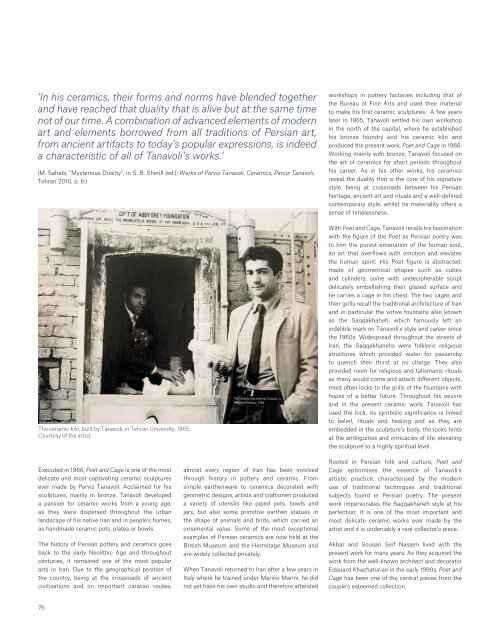NOW AND TEN
DUB1241_SaleCat
DUB1241_SaleCat
You also want an ePaper? Increase the reach of your titles
YUMPU automatically turns print PDFs into web optimized ePapers that Google loves.
‘In his ceramics, their forms and norms have blended together<br />
and have reached that duality that is alive but at the same time<br />
not of our time. A combination of advanced elements of modern<br />
art and elements borrowed from all traditions of Persian art,<br />
from ancient artifacts to today’s popular expressions, is indeed<br />
a characteristic of all of Tanavoli’s works.’<br />
(M. Sahabi, “Mysterious Duality”, in S. B. Sherill (ed.), Works of Parviz Tanavoli, Ceramics, Parviz Tanavoli,<br />
Tehran 2010, p. 8.)<br />
workshops in pottery factories including that of<br />
the Bureau of Fine Arts and used their material<br />
to make his frst ceramic sculptures. A few years<br />
later in 1965, Tanavoli settled his own workshop<br />
in the north of the capital, where he established<br />
his bronze foundry and his ceramic kiln and<br />
produced the present work, Poet and Cage in 1966.<br />
Working mainly with bronze, Tanavoli focused on<br />
the art of ceramics for short periods throughout<br />
his career. As in his other works, his ceramics<br />
reveal the duality that is the core of his signature<br />
style, being at crossroads between his Persian<br />
heritage, ancient art and rituals and a well-defned<br />
contemporary style, whilst its materiality ofers a<br />
sense of timelessness.<br />
The ceramic kiln, built by Tanavoli, in Tehran University, 1965.<br />
Courtesy of the artist.<br />
With Poet and Cage, Tanavoli recalls his fascination<br />
with the fgure of the Poet as Persian poetry was<br />
to him the purest emanation of the human soul,<br />
an art that overfows with emotion and elevates<br />
the human spirit. His Poet fgure is abstracted,<br />
made of geometrical shapes such as cubes<br />
and cylinders, some with undecipherable script<br />
delicately embellishing their glazed surface and<br />
he carries a cage in his chest. The two cages and<br />
their grills recall the traditional architecture of Iran<br />
and in particular the votive fountains also known<br />
as the Saqqakhaneh, which famously left an<br />
indelible mark on Tanavoli’s style and career since<br />
the 1960s. Widespread throughout the streets of<br />
Iran, the Saqqakhanehs were folkloric religious<br />
structures which provided water for passersby<br />
to quench their thirst at no charge. They also<br />
provided room for religious and talismanic rituals<br />
as many would come and attach diferent objects,<br />
most often locks to the grills of the fountains with<br />
hopes of a better future. Throughout his oeuvre<br />
and in the present ceramic work, Tanavoli has<br />
used the lock; its symbolic signifcance is linked<br />
to belief, rituals and healing and as they are<br />
embedded in the sculpture’s body, the locks hints<br />
at the ambiguities and intricacies of life, elevating<br />
the sculpture to a highly spiritual level.<br />
Executed in 1966, Poet and Cage is one of the most<br />
delicate and most captivating ceramic sculptures<br />
ever made by Parviz Tanavoli. Acclaimed for his<br />
sculptures, mainly in bronze, Tanavoli developed<br />
a passion for ceramic works from a young age,<br />
as they were dispersed throughout the urban<br />
landscape of his native Iran and in people’s homes,<br />
as handmade ceramic pots, plates or bowls.<br />
The history of Persian pottery and ceramics goes<br />
back to the early Neolithic Age and throughout<br />
centuries, it remained one of the most popular<br />
arts in Iran. Due to the geographical position of<br />
the country, being at the crossroads of ancient<br />
civilisations and on important caravan routes,<br />
almost every region of Iran has been involved<br />
through history in pottery and ceramic. From<br />
simple earthenware to ceramics decorated with<br />
geometric designs, artists and craftsmen produced<br />
a variety of utensils like piped pots, bowls and<br />
jars, but also some primitive earthen statues in<br />
the shape of animals and birds, which carried an<br />
ornamental value. Some of the most exceptional<br />
examples of Persian ceramics are now held at the<br />
British Museum and the Hermitage Museum and<br />
are widely collected privately.<br />
When Tanavoli returned to Iran after a few years in<br />
Italy where he trained under Marino Marini, he did<br />
not yet have his own studio and therefore attended<br />
Rooted in Persian folk and culture, Poet and<br />
Cage epitomises the essence of Tanavoli’s<br />
artistic practice, characterised by the modern<br />
use of traditional techniques and traditional<br />
subjects found in Persian poetry. The present<br />
work impersonates the Saqqakhaneh style at his<br />
perfection; it is one of the most important and<br />
most delicate ceramic works ever made by the<br />
artist and it is undeniably a rare collector’s piece.<br />
Akbar and Sousan Seif Nasseri lived with the<br />
present work for many years. As they acquired the<br />
work from the well-known architect and decorator<br />
Edouard Khachaturian in the early 1990s, Poet and<br />
Cage has been one of the central pieces from the<br />
couple’s esteemed collection.<br />
76


